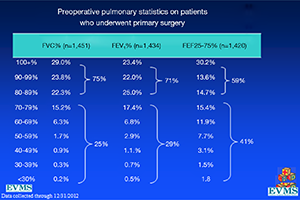Diminished pulmonary function in pectus excavatum: from denying the problem to finding the mechanism
Abstract
Background: Recently, technical improvement in the ability to measure lung function and the severity of chest deformity have enabled progress in understanding the mechanism of limitations of lung function in pectus excavatum.
Methods: After establishing that most patients with pectus excavatum do have symptoms of exercise intolerance, easy fatigability, and shortness of breath with exertion, lung function has been evaluated by a variety of methods in different centers. Spirometry, plethysmography, exercise testing, oculo electronic plethysmography, and imaging methods have been used to assess lung function in pectus excavatum and its response to surgery.
Results: Not all patients with pectus excavatum have subnormal static pulmonary function testing; some have above-average values. However, in more than 1500 adult and pediatric surgical patients with anatomically severe pectus excavatum at a single center, the bell curve of FVC, FEV1, and FEF 25-75 is shifted to significantly lower values in pectus excavatum. The curve is shifted to higher values after operation by approximately one standard deviation. Previous work has demonstrated that patients with more anatomically severe pectus excavatum are more likely to have diminished PFT’s. A mechanism for this effect is seen by oculo electronic plethysmography, which demonstrates that the depressed portion of the chest does not move on respiration. After Nuss procedure, the chest wall motion used to create suction to draw air into the lungs is indistinguishable from that of persons with a normal chest, and the intrathoracic volume is markedly increased.
Conclusions: Pectus excavatum is accompanied in most patients by diminished static pulmonary function. Correction by Nuss procedure results in improvement in chest wall motion; this improvement in the thoracic bellows action is accompanied by improvement in pulmonary function testing.
Cover






